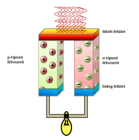






Conducting polymer-based hybrid materials with thermoelectric properties 


The main drawback however, is the limited electric conductivity of the polymers. In the course of our research we prepare organic/inorganic hybrids, in which we exploit the large Seebeck-coefficient of the polymer, and the high electric conductivity of
organic/inorganic hybrids, in which we exploit the large Seebeck-coefficient of the polymer, and the high electric conductivity of the incorporated nanoparticles (e.g., Au, Ag, nanoscopic carbon).
the incorporated nanoparticles (e.g., Au, Ag, nanoscopic carbon).  So far we prepared silver doped polythiophene derivatives and polypyrrole, with tunable conductivity and thermoelectric
So far we prepared silver doped polythiophene derivatives and polypyrrole, with tunable conductivity and thermoelectric property as well as bismuth telluride containing composites. New directions of our experiments are the study of conducting
property as well as bismuth telluride containing composites. New directions of our experiments are the study of conducting polymers with 1D nanostructure (e.g., nanofibers), and to fill of carbon nanotube structure (arrays or carpets) with conducting
polymers with 1D nanostructure (e.g., nanofibers), and to fill of carbon nanotube structure (arrays or carpets) with conducting polymers.
polymers. References:
References: Study on the electrodeposition of organic and inorganic thermoelectric materials for composite preparation
Krivan E, Bencsik G, Janaky C, et al.,
Study on the electrodeposition of organic and inorganic thermoelectric materials for composite preparation
Krivan E, Bencsik G, Janaky C, et al.,  REACTION KINETICS AND CATALYSIS LETTERS Volume: 96 Issue: 2 Pages: 429-436
REACTION KINETICS AND CATALYSIS LETTERS Volume: 96 Issue: 2 Pages: 429-436  Characterization of Poly(3-octylthiophene)/Silver nanocomposites prepared by solution doping
Characterization of Poly(3-octylthiophene)/Silver nanocomposites prepared by solution doping  Pinter E, Fekete ZA, Berkesi O, et al.,
Pinter E, Fekete ZA, Berkesi O, et al.,  JOURNAL OF PHYSICAL CHEMISTRY C Volume: 111 Issue: 32 Pages: 11872-11878
JOURNAL OF PHYSICAL CHEMISTRY C Volume: 111 Issue: 32 Pages: 11872-11878 
 organic/inorganic hybrids, in which we exploit the large Seebeck-coefficient of the polymer, and the high electric conductivity of
organic/inorganic hybrids, in which we exploit the large Seebeck-coefficient of the polymer, and the high electric conductivity of the incorporated nanoparticles (e.g., Au, Ag, nanoscopic carbon).
the incorporated nanoparticles (e.g., Au, Ag, nanoscopic carbon).  So far we prepared silver doped polythiophene derivatives and polypyrrole, with tunable conductivity and thermoelectric
So far we prepared silver doped polythiophene derivatives and polypyrrole, with tunable conductivity and thermoelectric property as well as bismuth telluride containing composites. New directions of our experiments are the study of conducting
property as well as bismuth telluride containing composites. New directions of our experiments are the study of conducting polymers with 1D nanostructure (e.g., nanofibers), and to fill of carbon nanotube structure (arrays or carpets) with conducting
polymers with 1D nanostructure (e.g., nanofibers), and to fill of carbon nanotube structure (arrays or carpets) with conducting polymers.
polymers. References:
References: Study on the electrodeposition of organic and inorganic thermoelectric materials for composite preparation
Krivan E, Bencsik G, Janaky C, et al.,
Study on the electrodeposition of organic and inorganic thermoelectric materials for composite preparation
Krivan E, Bencsik G, Janaky C, et al.,  REACTION KINETICS AND CATALYSIS LETTERS Volume: 96 Issue: 2 Pages: 429-436
REACTION KINETICS AND CATALYSIS LETTERS Volume: 96 Issue: 2 Pages: 429-436  Characterization of Poly(3-octylthiophene)/Silver nanocomposites prepared by solution doping
Characterization of Poly(3-octylthiophene)/Silver nanocomposites prepared by solution doping  Pinter E, Fekete ZA, Berkesi O, et al.,
Pinter E, Fekete ZA, Berkesi O, et al.,  JOURNAL OF PHYSICAL CHEMISTRY C Volume: 111 Issue: 32 Pages: 11872-11878
JOURNAL OF PHYSICAL CHEMISTRY C Volume: 111 Issue: 32 Pages: 11872-11878 
Conducting polymers have prominently large Seebeck-coefficient - some cases it can even exceed 1mV/K, which is five times larger than that of bismuth telluride (Bi2Te3), the most
even exceed 1mV/K, which is five times larger than that of bismuth telluride (Bi2Te3), the most frequently used inorganic thermoelectric material. This fact makes CPs attractive candidates for
frequently used inorganic thermoelectric material. This fact makes CPs attractive candidates for fabricating new generation lightweight and flexible thermoelectric materials. In addition,
fabricating new generation lightweight and flexible thermoelectric materials. In addition, polymers generally have low thermal conductivity, which is also an important factor in the high
polymers generally have low thermal conductivity, which is also an important factor in the high thermoelectric figure of merit.
thermoelectric figure of merit.
 even exceed 1mV/K, which is five times larger than that of bismuth telluride (Bi2Te3), the most
even exceed 1mV/K, which is five times larger than that of bismuth telluride (Bi2Te3), the most frequently used inorganic thermoelectric material. This fact makes CPs attractive candidates for
frequently used inorganic thermoelectric material. This fact makes CPs attractive candidates for fabricating new generation lightweight and flexible thermoelectric materials. In addition,
fabricating new generation lightweight and flexible thermoelectric materials. In addition, polymers generally have low thermal conductivity, which is also an important factor in the high
polymers generally have low thermal conductivity, which is also an important factor in the high thermoelectric figure of merit.
thermoelectric figure of merit.




















